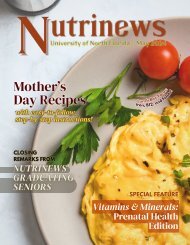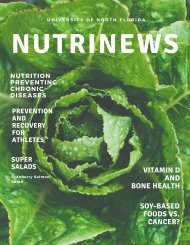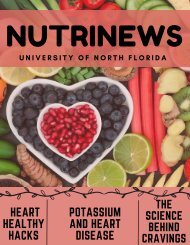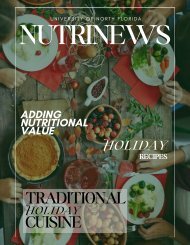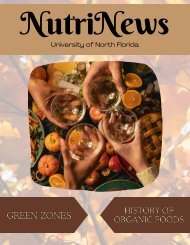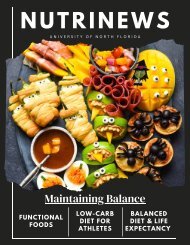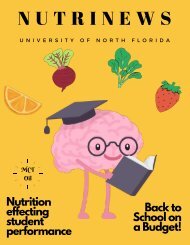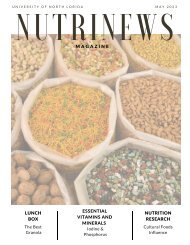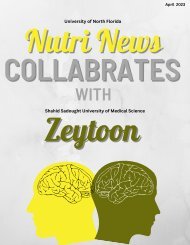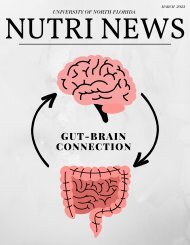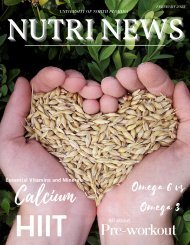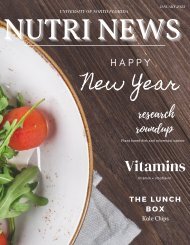August 2021 (1)
Create successful ePaper yourself
Turn your PDF publications into a flip-book with our unique Google optimized e-Paper software.
Nutri News<br />
The University of North Florida<br />
Department of Nutrition and Dietetics<br />
The<br />
<strong>August</strong> <strong>2021</strong>
TABLE OF<br />
CONTENTS<br />
C O V I D C O R N E R<br />
M O N T H L Y H A C K S<br />
U N F C L U B U P D A T E S<br />
S H O P P I N G I N S E A S O N : J A C K F R U I T<br />
S T U D E N T S P O T L I G H T<br />
S U S T A I N A B I L I T Y O F L O C A L F O O D<br />
D I E T A R Y H A B I T S O F I R A N I A N S<br />
M Y T H B U S T I N G<br />
T H E L U N C H B O X<br />
N U T R I T I O N R E S E A R C H<br />
F A C U L T Y S P O T L I G H T<br />
M E E T T H E S T A F F<br />
2<br />
4<br />
7<br />
9<br />
11<br />
15<br />
17<br />
21<br />
25<br />
27<br />
30<br />
33<br />
1
U N F<br />
2<br />
C O V I D C O R N E R<br />
Ospreys, we are back and ready to rock out another year here at UNF! This Fall will be<br />
the first time for many students, not just incoming freshmen, to participate in oncampus<br />
activities and in-person classes actively. Here at NutriNews, we welcome all<br />
of you and hope you enjoy the beautiful campus and get in the much-needed<br />
interaction with your peers and professors.<br />
Over the summer term, UNF released updated COVID guidelines based on “four key<br />
pillars of shared responsibility.”<br />
1.Vaccinations:<br />
Getting vaccinated is not mandatory at UNF. However, in order to keep students<br />
and faculty healthy and safe, getting vaccinated is highly recommended.<br />
Proof of vaccination may be required for athletics, student housing, student health<br />
services, and some off-campus opportunities such as clinics and internships.<br />
On-campus COVID testing and vaccinations are regularly available for students and<br />
faculty. For more information and important dates, visit the Student Health Services<br />
(SHS) website or email studenthealth@unf.edu.<br />
2. Wear a Mask:<br />
Masks are no longer mandatory on campus but are recommended to all; especially<br />
with the high COVID case numbers and new variant.<br />
Services cannot be denied to those who choose not to wear a mask.<br />
3. Hygiene:<br />
Proper hygiene and regular handwashing are always highly encouraged.<br />
The University will continue providing sanitizing stations throughout the campus as<br />
well as maintaining the disinfection of all UNF facilities.<br />
4. Sick = Stay Home:<br />
Anyone who is ill or showing symptoms is advised to remain home. Those living on<br />
campus should contact SHS.<br />
All positive COVID cases should be reported via the SHS Self-Reporting Form found<br />
on the SHS website.<br />
Through all the precautions taken over the last year, we are now able to return to<br />
campus. Let’s continue to be mindful that the virus is still out there, and we need to keep<br />
ourselves healthy. Now go explore your campus, ask your professors all of the questions,<br />
set attainable goals to achieve this semester, and take care of yourselves, Ospreys!
Back to<br />
3<br />
<strong>August</strong> 23<br />
SCHOOL
Monthly Hacks:<br />
B Y : M E L I S S A B R E N N A N , M . S .<br />
Managing Back to School<br />
Chaos<br />
The start of the Fall semester brings exciting<br />
energy as the campus opens up to students again,<br />
and resuming in-person classes. Being back on<br />
campus can also bring nervous energy, as students<br />
have been learning and operating from home for<br />
over a year. Not only are classes transitioning to<br />
in-person again, but so are student organizations,<br />
classes, meetings, and jobs. This can all feel<br />
overwhelming, but there are some things you can<br />
do to manage the back-to-school chaos!<br />
4
the week starts, look over the syllabus and<br />
Before<br />
note of due dates, readings that need to<br />
make<br />
read, and any school-related tasks that need<br />
be<br />
be accomplished. This is also a good time to<br />
to<br />
at work schedules and weekly commitments<br />
look<br />
see how they fit in around classes. Coming up<br />
to<br />
a weekly plan or to-do list can help you look<br />
with<br />
the week as a whole and give you some<br />
at<br />
Breaking up all those larger tasks<br />
perspective.<br />
daily tasks can help keep you on track during<br />
into<br />
and agendas become very helpful when<br />
Planners<br />
the fall semester, trying to keep track of<br />
entering<br />
meeting and due date that comes up.<br />
every<br />
everything written out on paper or in your<br />
Having<br />
calendar is a great way to stay on track<br />
phone<br />
manage the chaos.<br />
and<br />
most people hear meal prepping, they may<br />
When<br />
of the classic chicken, rice, and bland<br />
think<br />
prepared in bulk and divided amongst a<br />
veggies<br />
of individual containers. However, meal<br />
plethora<br />
is a lot more fun and delicious than<br />
prepping<br />
that!<br />
prepping depends on the individual and is a<br />
Meal<br />
used to create more time during the week by<br />
tool<br />
foods or meals in advance. This could<br />
prepping<br />
like cooking an entire meal that you love and<br />
look<br />
it in microwavable containers for<br />
dividing<br />
later in the week. However, it could<br />
convenience<br />
look like cutting up produce in advance to<br />
also<br />
on hand for snacking or recipes. You could<br />
have<br />
prep breakfasts, lunch, dinner, snacks,<br />
meal<br />
whatever you need help with during your<br />
dessert,<br />
5<br />
Plan Ahead<br />
the week.<br />
Meal Prep<br />
busy week.
usy and demanding schedule can sometimes<br />
A<br />
havoc on your personal life when trying to<br />
wreak<br />
everything in. Being flexible and open to<br />
fit<br />
during hectic times can help ease the<br />
change<br />
when juggling many commitments. Plans<br />
stress<br />
have to change or be moved to fit everything<br />
may<br />
but that is okay! Many students and professors<br />
in,<br />
transitioning back to in-person classes<br />
are<br />
so being flexible and compassionate<br />
together,<br />
go a long way!<br />
can<br />
a busy schedule can be fun and exciting,<br />
Having<br />
it can also become exhausting very quickly.<br />
but<br />
happens, especially in college, so being<br />
Burnout<br />
of signs that you are overworked can help<br />
aware<br />
burnout down the road.<br />
mitigate<br />
time for yourself to practice self-care can<br />
Taking<br />
a great way to regroup. Self-care Sunday is a<br />
be<br />
trend seen on social media, but you can<br />
big<br />
self-care at any point in the week when<br />
practice<br />
need it. Self-care is very individual and<br />
you<br />
on the person, but it could look like<br />
depends<br />
during a busy day to take deep breaths<br />
pausing<br />
being present, engaging in joyful activity,<br />
and<br />
some sunshine, reading your favorite<br />
getting<br />
spending time with friends and family. The<br />
book,<br />
is endless! Time spent on yourself to recharge<br />
list<br />
regroup can help you tackle the rest of the<br />
and<br />
and responsibilities you need to take on<br />
tasks<br />
matter how chaotic your back-to-school schedule is, there are always things you can do, big or<br />
No<br />
to make it a little bit easier on yourself in the process. Plan ahead to evaluate your schedule in<br />
small,<br />
be flexible when encountering scheduling conflicts, meal prep to stay nourished and save<br />
advance,<br />
and always take time for yourself when you need it.<br />
time,<br />
Practice Being<br />
Flexible<br />
Take Time to<br />
Regroup<br />
during the week.<br />
6
7<br />
UNF Nutrition and Food Clubs<br />
B Y : L A U R A R O D G E R S<br />
Here at UNF, we have many nutrition and food-related clubs which are run by<br />
brilliant, dedicated dietetic students. Finding a group of people who share the<br />
same passions is special but can be difficult to find. Luckily, the Department of<br />
Nutrition & Dietetics has quite a few different clubs to choose from.<br />
NDLA –Nutrition and Dietetic Leadership Association<br />
“The Nutrition and Dietetics Leadership Association focuses on the development of leadership skills in<br />
hopes to provide guidance in the learning of what qualities are needed to be a leader in the field of<br />
dietetics. The NDLA attends Legislative Day which allows our club members to observe and meet<br />
legislators. It gives insight into the process of lawmaking and provides a forum to see leaders in action.<br />
Also, NDLA hosts an Internship Symposium which provides insight into what qualities and<br />
qualifications are sought after by institutions sorting through intern applications.”<br />
President: Samantha Burke<br />
Monthly Meetings: every 2nd Monday at 3 pm<br />
@unf_ndla<br />
SNDA –Student Nutrition and Dietetic Association<br />
“The Student Nutrition and Dietetics Association is a student organization that educates UNF students<br />
on the growing field of nutrition and shares opportunities to participate on campus and in the<br />
community. SNDA leads a student mentorship program called Apples to Apples where seniors are<br />
given the chance to guide and cultivate underclassmen within the nutrition program from their own<br />
experiences. We are currently looking for members for the mentorship program throughout <strong>August</strong>.<br />
All student club meetings will take place on the second Wednesday of each month starting on the 8th of<br />
September at 10 am to 11 am.”<br />
President: Dalila Mumic<br />
Meetings: every 2nd Wednesday at 10 am<br />
@unf_snda<br />
NJC –Nutrition Journal Club<br />
“The Nutrition Journal Club is an educational tool that provides a place for students to get together to<br />
discuss stimulating and exciting research. Students do not need to be well versed in clinical jargon or<br />
have experience analyzing scholarly journal articles to participate. Our meetings are designed to<br />
introduce fresh topics, explain innovative research, and generate thought-provoking conversations<br />
among students in a stress-free, fun environment. Students will learn about recent research within the<br />
Nutrition and Dietetics field that is also relevant to their current curriculum.”<br />
President: Madi Walker<br />
Monthly Meetings: every 1st Wednesday<br />
@unf_njc
8
9
11<br />
STUDENT SPOTLIGHT:<br />
KARLA GUERRA<br />
B Y C A R O L R I G G I N S<br />
Welcome back, Ospreys! Meet Karla Guerra! Karla is currently a communications team<br />
member with the Florida Academy of Nutrition and Dietetics and will begin UNF’s Master of<br />
Science in Nutrition and Dietetics program and internship this Fall. She has devoted much of<br />
her time at UNF to the NLDA as an Officer, as an ambassador for Brook10, and to<br />
NutriNews while in UNF’s Nutrition and Dietetics Undergraduate Program as the former<br />
face behind the Student Spotlight! Karla was born in El Paso, Texas, and is a mother to a<br />
beautiful 7-year-old boy named Matthew. Continue reading to learn more about Karla’s<br />
inspiring journey as a student at UNF.<br />
CR: What inspired you to pursue a degree in Nutrition and<br />
Dietetics?<br />
KG: I was always interested in nutrition when it came to<br />
having a healthy lifestyle; however, when I went off to<br />
college, I decided to pursue a degree in digital filmmaking.<br />
A few years later, after college and having my son, I<br />
decided to go back to school and change my degree to<br />
nutrition and dietetics at UNF. I was inspired to pursue a<br />
degree in nutrition because I wanted to learn the science of<br />
food and its importance to our overall health.
12<br />
CR: What do you enjoy doing with your time outside of the classroom?<br />
KG: Most of my time outside of school, I like to relax and enjoy time with my son.<br />
School can take so much time from you, so I mostly spend my free time with my son<br />
and family. We like to go swimming, playing with Legos and watching movies.<br />
CR: You spent a lot of time<br />
working at the Ogier Gardens.<br />
What was your favorite thing about<br />
working there?<br />
KG: The garden is a great place to<br />
learn how to grow organic fruits<br />
and vegetables. I loved interacting<br />
with students who volunteer at the<br />
garden and applying the nutrition<br />
knowledge from the courses I had<br />
taken with the crops grown at the<br />
garden. It is a great place to<br />
volunteer and have fun while<br />
learning about agriculture<br />
CR: What challenged you the most during your time in the Undergraduate Program?<br />
KG: What challenged me the most during the program was balancing schoolwork,<br />
work, and volunteering while also taking care of my son. I had to stick to a strict<br />
schedule to not get overwhelmed with everything. I have a monthly planner where I<br />
write everything and make sure that I stick to it to get work done on time. When you<br />
have a schedule and stick to it, it makes the whole program manageable.<br />
CR: What did you enjoy most about the Undergraduate Program?<br />
KG: The nutrition and dietetics program at UNF is fantastic. I had such a great<br />
experience! The professors are helpful and supportive, and they take the time to get<br />
to know their students. I really enjoyed spending time with my classmates and<br />
getting to bond over so many things we are passionate about. It is hard to pin one<br />
thing that I wanted the most because it was all so great, even the moments where I<br />
felt like I was being challenged by some of the courses. After all, that's where I<br />
learned and grew the most.
13<br />
CR: What advice do you have for students who are interested in attending the<br />
Combined Master's/Internship Program at UNF?<br />
KG: I will start the MSDI program this coming fall semester. I am excited and nervous,<br />
but I recommend anyone interested. My experience at UNF has been great, and I am so<br />
grateful to continue my education and get to do the internship with UNF. My advice to<br />
anyone on the path to becoming an RD is to not be afraid to apply for an internship. It<br />
may feel overwhelming, but it is so worth it. The nutrition clubs have a lot of information<br />
and advice on how to apply for DICAS.<br />
CR: What excites you most about the Master's program?<br />
KG: When I first started the nutrition program, I would have never imagined myself<br />
continuing my education after my bachelor's degree. I decided to apply for the Master's<br />
program during the last semester of my undergrad because I felt like I still had so much<br />
to learn. If I could do the nutrition undergrad program, I could achieve the Master's<br />
program as well. I am nervous but excited to complete a master's degree while also<br />
doing my internship to become an RD.<br />
CR: What are your career goals after completing the Master's/Internship Program?<br />
KG: My goal is to become a registered dietitian and work as a community dietitian.<br />
There are so many aspects of nutrition that I love, so I am still unsure what path I will<br />
take after my internship. Still, I know for sure that I want to become an RD and serve<br />
others on their approach to health.<br />
CR: Do you have a favorite inspiring<br />
quote or mantra that you live by and<br />
would like to share with others?<br />
KG: "We keep moving forward—<br />
opening up new doors and doing<br />
new things—because we're curious.<br />
And curiosity keeps leading us<br />
down new paths." – Walt Disney. I<br />
have this quote as my laptop screen<br />
saver. During times I felt overwhelmed<br />
and felt stuck, I kept reminding myself<br />
to keep moving forward.
Dietary<br />
Habits of<br />
Iranians<br />
Iran is a country located in western Asia. Iran<br />
covers a total area of 1,648,195 square<br />
kilometers and is subdivided into 31 provinces<br />
with 83 million inhabitants. The Persian Gulf<br />
and the Gulf of Oman are located on the<br />
southern border of Iran. In the north, there are<br />
lush forests making up much of the northern<br />
border of the country near the shores of the<br />
Caspian Sea.<br />
Iran also is a mountainous country consisting of<br />
the Persian Plateau, mostly in the western part<br />
of Iran. The eastern part of Iran consists mostly<br />
of desert basins. The geography of Iran, from<br />
north to south of Iran and from east to west,<br />
with its diverse climates, ethnicities, and<br />
cultures, has created many varieties in food and<br />
cuisine.<br />
Iranian national cuisine is truly various and<br />
nutritious. Iranians usually have three meals a<br />
day, almost all of them accompanied by bread or<br />
rice. Although they vary in different regions,<br />
rice- and bread-based diets are generally used<br />
by all people throughout the country. Iranians<br />
consume about 100 gr of rice per day.1<br />
Different types of bread, particularly wheatbased<br />
ones, are prepared and consumed by all<br />
people in the country; most Iranians prefer their<br />
traditional bread such as lavash, taftoon,<br />
sangak, and barbari.2 Iranian people are the<br />
second-largest consumer of bread in the world,<br />
averaging 160 kilograms for each person.2,3<br />
The most popular beverage, which is highly<br />
consumed by all Iranians, is tea.<br />
17
As mentioned, each region of Iran has its own<br />
types of traditional food due to the region’s<br />
ecosystem. For instance, the southern people<br />
love spicy and hot flavors; on the contrary, the<br />
northern cuisine is often sour.4 Southern<br />
cuisine is chiefly based on fresh seafood, for<br />
instance, Ghaliyeh-Mahi, an herbed fish stew.4<br />
The north provides Iran with most of the water<br />
needed for farming, so the main ingredients in<br />
recipes are crops, vegetables, and some special<br />
green herbs, and salted and smoked fish are<br />
highly consumed.4<br />
In western Iran, which is known as the Kurdish<br />
region, there are varieties of local āsh (a kind of<br />
thick soup), pilaf, and stew dishes and several<br />
kebabs such as dande kabāb, a local Kurdish<br />
dish which includes traditional grilled rib meat.4<br />
Khorasan Razavi, a province located in the east<br />
of Iran, is famous for its local food called Shole<br />
Mashhadi, named for the capital city of Mashad.<br />
The main ingredients of this dish are plenty of lamb<br />
meat, beans, and spices. Moreover, Mashad is<br />
known as the main producer of saffron, a national<br />
and popular spice that is also called “red gold” in<br />
Iran.4<br />
Iranians make a wide range of sweets and<br />
confectionery, particularly in the central and<br />
northwest areas: qutab in Yazd province, gaz in<br />
Isfahan province, Shiraz Meskhetian in Fars<br />
province, Tabriz baklava, Noghl (a type of comfit)<br />
with different flavors, and Black halo in East and<br />
West Azerbaijan, respectively, and Ardabil<br />
province.4<br />
Like other countries, Iran is facing a transition<br />
in dietary intakes which have put a burden on<br />
the health system; the modernization of food<br />
intakes has created a high intake of fast foods<br />
and carbonated drinks. Lack of physical activity,<br />
specifically in urban areas, is becoming a<br />
problem in Iran. Therefore, the prevalence of<br />
obesity as a risk factor of several chronic<br />
diseases is increasing.5,6<br />
The prevalence of diabetes and cardiovascular<br />
disease has dramatically increased in recent<br />
years, so it seems Iranians might benefit from<br />
keeping their traditional dietary habits and<br />
increasing their physical activity.5.6<br />
18<br />
1. Karizaki VM. Ethnic and Traditional Iranian Rice-Based Foods. J Ethnic Foods. 2016;3(2);124-134. doi:10.1016/j.jef.2016.05.002.<br />
2. Karizaki VM. Ethnic and Traditional Iranian Breads: Different Types, and Historical and Cultural Aspects. J Ethnic Foods.2017;4(1);8-14. doi: 10.1016/j.jef.2017.01.002.<br />
3. Alami A, Banoorkar S, Rostamiyan T, Asadzadeh S N, Morteza M M. Quality assessment of traditional breads in Gonabad bakeries, Iran. J Research Health. 2014; 4 (3) :835-841. http://jrh.gmu.ac.ir/article-1-435-en.html.<br />
4. Emadzadeh B, Ghorani B. Textural Characteristics of Iranian Foods: Cuisine Signifies Old Historical Identities. In: Emadzadeh B, Ghorani B, Nishinari K ed. Textural Characteristics of World Foods. Hoboken, NJ:John Wiley and
19<br />
Ghorme Sabzi<br />
Yield: 4 to 5 people<br />
However, as we talked about, different regions of Iran have distinct variations of tastes and<br />
flavors, sometimes some foods, such as Qormeh Sabzi have become more popular and are<br />
cooked in all parts of Iran. Here is a recipe for this most popular herb stew, which most<br />
Iranians love this food especially with grand mom’s hand cooking; I hope you will enjoy it<br />
too.<br />
INGREDIENTS:<br />
PROCEDURES:<br />
Oil<br />
the red beans for at least 3 hours.<br />
1. Soak<br />
12 tablespoon red kidney beans (3<br />
green herbs and let them fry in a big pan<br />
2. Chop<br />
tablespoons for each person)<br />
on medium heat for 70 to 90 minutes.<br />
Green herbs:<br />
dice an onion and chop beef or<br />
3. Meanwhile,<br />
Parsley 200 gr<br />
lamb meat.<br />
oil in a large pot over medium-high heat.<br />
4. Heat<br />
Fenugreek 100 gr<br />
Add onion; cook and stir until deep golden<br />
Coriander 100 gr<br />
brown.<br />
Chives 200 gr<br />
in turmeric for 1 to 2 minutes.<br />
5. Stir<br />
meat, garlic powder, and pepper; cook<br />
6. Add<br />
Spinach 200 gr<br />
1 Onion<br />
and simmer for 25 minutes (in the frying<br />
process of meat/green herbs if you feel it is<br />
Beef or lamb meat 200 gr (50 gr for each<br />
going to burn, add water).<br />
person)<br />
green herbs, dried lime, soaked beans,<br />
7. Add<br />
3 Dried lime<br />
and water to the meat.<br />
Turmeric 1 teaspoon<br />
it boil, then put the lid and let it cook for 3<br />
8. Let<br />
Garlic powder 1 teaspoon<br />
hours.<br />
Black peppers 1/2 teaspoons<br />
with cooked white rice.<br />
9. Serve
According to Salem Press<br />
Encyclopedia of Health, “Fasting is<br />
the act of abstaining from food and<br />
drinks (and sometimes other<br />
activities) for a specified period. It<br />
has been practiced for thousands of<br />
years and for a variety of purposes.<br />
Most people fast for religious<br />
reasons, medical procedures, and<br />
dietary purposes”. 1 Intermittent<br />
fasting describes an eating pattern<br />
involving eating and abstaining from<br />
eating for set and scheduled amounts<br />
of time. Fasting often occurs for up<br />
to 24-hours at a time, one to two<br />
times per week 2, however, there are<br />
various ways to implement the<br />
technique, including simply skipping<br />
meals when there is no feeling of<br />
hunger present. 3 During fasting<br />
periods, it is still necessary to stay<br />
hydrated with generous amounts of<br />
water, and low-calorie drinks are<br />
typically permitted.<br />
Arguably, the most common reason people<br />
choose to try intermittent fasting is to lose<br />
weight. When the body enters a caloric<br />
deficit, more meaning more calories are<br />
being burned than consumed, the body<br />
uses previously-stored fat as an immediate<br />
energy source. This leads to weight loss<br />
over time. Research shows that this can be<br />
effective, but if the meals consumed during<br />
allotted eating times are not nutritionally<br />
adequate, this method can lead to various<br />
nutritional deficiencies, and can encourage<br />
binge eating.2<br />
Aside from weight loss, advocates of<br />
intermittent fasting boast about<br />
physiological improvements such as<br />
increased resistance to disease, increased<br />
resistance to stress, and increased<br />
longevity of brain function.3 Additionally,<br />
fasting has been thought to boost the<br />
immune system by inducing autophagy. 4,<br />
5 Autophagy is a contributing factor of<br />
homeostasis for overall survival, and the<br />
liver is an organ which responds well to<br />
autophagy, as seen during studies on cell<br />
reactions to fasting. 4<br />
22
23<br />
References:<br />
. Harmon A. Fasting. Salem Press Encyclopedia of Health. 2020. Accessed June 28, <strong>2021</strong>. https://search.ebscohost.com/login.aspx?direct=true&AuthType=shib&db=ers&AN=87322080&site=eds-live&scope=site<br />
. Collier R. Intermittent fasting: the science of going without. CMAJ. 2013;185(9):E363-E364. doi:10.1503/cmaj.109-4451<br />
. Gunnars, K., <strong>2021</strong>. 6 Popular Ways to Do Intermittent Fasting. Healthline website. Updated March 25, <strong>2021</strong>. Accessed June 30, <strong>2021</strong>. https://www.healthline.com/nutrition/6-ways-to-do-intermittentasting#TOC_TITLE_HDR_7<br />
. Hannan MA, Rahman MA, Rahman MS, et al. Intermittent fasting, a possible priming tool for host defense against SARS-CoV-2 infection: Crosstalk among calorie restriction, autophagy and immune response. Immunol<br />
ett. 2020;226:38-45. Accessed June 30, <strong>2021</strong>. doi:10.1016/j.imlet.2020.07.001.<br />
. Alirezaei M, Kemball C, Flynn C, et al. Short-term fasting induces profound neuronal autophagy. Autophagy. 2010;6(6):702-710. Accessed June 30, <strong>2021</strong>. doi:10.4161/auto.6.6.1237 6.<br />
I S F A S T I N G<br />
T H E R I G H T<br />
D I E T I N G<br />
M E T H O D<br />
F O R Y O U ?<br />
Since intermittent fasting has<br />
been proven to have physiological<br />
benefits, is it the right dieting<br />
method for you? It is important to<br />
consider factors such as lifestyle<br />
and nutritional needs when<br />
considering any diet, including<br />
intermittent fasting. For someone<br />
who wants to lose weight,<br />
reducing calories is necessary.<br />
Whether through scheduled eating<br />
such as fasting, or by cutting<br />
calories in a more consistent<br />
manner throughout a typical day, a<br />
reduction in calories is an efficient<br />
way to lose weight. In this<br />
scenario, it is still imperative to<br />
consume nutrient dense foods like<br />
vegetables during allotted eating<br />
times. For someone who struggles<br />
to maintain a healthy weight or<br />
someone who is an athlete trying<br />
to gain muscle, increasing calories<br />
and protein intake would be a more<br />
efficient diet plan than regularly<br />
planned fasting. To decide if<br />
intermittent fasting is right for you,<br />
consider your schedule and your<br />
needs. If you decide to implement<br />
an intermittent fasting plan, start<br />
with small increments and pay<br />
attention to the way your body<br />
responds. Intermittent fasting<br />
should only be practiced to reset<br />
and aid your body, not to punish<br />
your body for eating.
25<br />
Recipe by: Paige Courtier<br />
The Lunch<br />
Box:<br />
Cranberry Almond Granola<br />
I N G R E D I E N T S<br />
4 cups rolled oats<br />
1 cup raw sliced almonds<br />
2 cup raw pumpkin seeds<br />
1 tsp sea salt<br />
1 tsp cinnamon<br />
½ cup olive oil<br />
½ cup maple syrup<br />
1 tsp vanilla extract<br />
2/3 cup dried cranberries<br />
D I R E C T I O N S<br />
1. Preheat oven to 350 F. Line a large, rimmed<br />
baking sheet with parchment paper.<br />
2. In a large mixing bowl, combine the rolled<br />
oats, raw pumpkin seed, salt, and cinnamon.<br />
(Sliced almonds will be added halfway to<br />
prevent burning.)<br />
3. Pour in oil, maple syrup, and vanilla. Mix<br />
thoroughly.<br />
4. Pour granola mixture onto the prepared pan<br />
and spread evenly.<br />
5. Bake for a total of 21-24 minutes. Stirring and<br />
adding in the sliced almonds halfway.<br />
6. The granola will further crisp as it cools- allow<br />
to rest for at least 45 minutes.<br />
7. Mix in the dried cranberries.<br />
8. Can be stored in an airtight container for up to<br />
2 weeks.<br />
9. Top onto yogurt with fresh berries for an easy<br />
on the breakfast or snack.
26<br />
Mediterranean<br />
Chickpea Salad<br />
Pita Pocket<br />
PROCEDURE<br />
INGREDIENTS<br />
Mediterranean Chickpea Salad:<br />
Mediterranean Chickpea Salad<br />
Cook quinoa and allow to cool prior to<br />
1.<br />
1 can chickpeas, rinsed and drained<br />
assembling; it helps to prepare the day<br />
1 cup quinoa, cooked & cooled<br />
before.<br />
2.<br />
1 large tomato<br />
Rinse and drain chickpeas.<br />
Dice the tomato, bell pepper, red onion,<br />
1 cucumber<br />
3.<br />
1 red bell pepper<br />
½ red onion<br />
cucumber, and cilantro.<br />
4.<br />
In a medium to a large bowl, mix together<br />
the quinoa & chickpeas; then combine in the<br />
2-3 sprigs of cilantro<br />
diced vegetables.<br />
Juice of ½ a lime<br />
Add in olive oil, rice vinegar, lime juice, and<br />
5.<br />
salt & pepper to taste.<br />
2 tbs olive oil<br />
2 tbs plain rice vinegar<br />
combine ingredients.<br />
6. Thoroughly<br />
Pita Pocket:<br />
(white wine vinegar works too)<br />
Slice avocado and place it into each half of<br />
1.<br />
Salt and pepper to taste<br />
the pita pockets. Add in cheese of choice<br />
Pocket<br />
Pita<br />
an avocado<br />
½<br />
and scoop a generous amount of the salad<br />
into each pita pocket.<br />
2.<br />
Feta or mozzarella<br />
Enjoy with a side of choice- chips, yogurt,<br />
2 pita pockets<br />
fruit, etc!
d i b l e s e a w e e d a n d k e l p<br />
E<br />
r o d u c t s a r e a n o r m a l p a r t o f<br />
p<br />
h e d i e t i n E a s t - A s i a n c u l t u r e s<br />
t<br />
n d h a v e r e c e n t l y m a d e a m o v e<br />
a<br />
v e r t o E u r o p e a n d t h e U n i t e d<br />
o<br />
t a t e s . C o n s u m e r s i n t h e U n i t e d<br />
S<br />
t a t e s n o w h a v e t h e o p t i o n t o<br />
S<br />
e t t h e i r s e a w e e d f i x f r o m<br />
g<br />
o m e t h i n g o t h e r t h a n s u s h i . O n e<br />
s<br />
e a s o n t h a t t h e s e e d i b l e<br />
r<br />
e a w e e d p r o d u c t s h a v e g a i n e d<br />
s<br />
o p u l a r i t y i s t h a t t h e y a r e<br />
p<br />
n o w n t o b e h e a l t h f o o d , o r<br />
k<br />
o m e w o u l d s a y a “ s u p e r - f o o d ” .<br />
s<br />
d i b l e s e a w e e d , o r m a c r o a l g a e ,<br />
E<br />
a n b e d i v i d e d i n t o t h r e e m a i n<br />
c<br />
r o u p s d i f f e r i n g i n c o l o r — r e d ,<br />
g<br />
r o w n , a n d g r e e n a l g a e . A l l o f<br />
b<br />
h e v a r i e t i e s a r e r i c h i n i o d i n e ,<br />
t<br />
u t t h e b r o w n v a r i a t i o n<br />
b<br />
e s p e c i a l l y k e l p ) c o n t a i n s t h e<br />
(<br />
o s t i o d i n e o u t o f a l l o f t h e m .<br />
m<br />
27<br />
C O M M E R C I A L L Y A V A I L A B L E K E L P A N D<br />
S E A W E E D P R O D U C T S – V A L U A B L E<br />
I O D I N E S O U R C E O R R I S K O F E X C E S S<br />
I N T A K E ?<br />
By: Haley Brock
n e r e a s o n t h e s e p r o d u c t s<br />
O<br />
r e s o h i g h i n i o d i n e i s t h a t<br />
a<br />
a c r o a l g a e a r e v e r y<br />
m<br />
f f i c i e n t i n a b s o r b i n g<br />
e<br />
n o r g a n i c c o m p o u n d s l i k e<br />
i<br />
i n e r a l s f r o m t h e s e a w a t e r<br />
m<br />
n d u s i n g t h o s e e l e m e n t s f o r<br />
a<br />
h e i r m e t a b o l i s m . I n t h e<br />
t<br />
r o w n a l g a e , t h e r e a r e<br />
b<br />
a l o p e r o x i d a s e s i n t h e c e l l<br />
h<br />
a l l t h a t h e l p t o i n c r e a s e<br />
w<br />
h e u p t a k e , c o n v e r s i o n , a n d<br />
t<br />
t o r a g e o f i o d i n e . I t i s<br />
s<br />
o s s i b l e t h e n t h a t t h e b r o w n<br />
p<br />
l g a e c a n h o l d m o r e i o d i n e<br />
a<br />
h a n t h e s u r r o u n d i n g w a t e r<br />
t<br />
v e n h o l d s .<br />
e<br />
o d i n e i s a n e s s e n t i a l<br />
I<br />
i c r o n u t r i e n t t h a t t h e b o d y<br />
m<br />
e e d s t o s y n t h e s i z e t h y r o i d<br />
n<br />
o r m o n e s p r o p e r l y . T h y r o i d<br />
h<br />
o r m o n e s a r e i m p o r t a n t f o r<br />
h<br />
h e r e g u l a t i o n o f a w i d e<br />
t<br />
a n g e o f p h y s i o l o g i c a l a n d<br />
r<br />
e l l u l a r f u n c t i o n s , l i k e<br />
c<br />
o r m a l g r o w t h a n d<br />
n<br />
e v e l o p m e n t , m e t a b o l i c<br />
d<br />
e g u l a t i o n , a n d n e u r a l<br />
r<br />
i f f e r e n t i a t i o n . W i t h o u t<br />
d<br />
n o u g h i o d i n e i n t h e d i e t , i t<br />
e<br />
s p o s s i b l e t o d e v e l o p a n<br />
i<br />
o d i n e d e f i c i e n c y d i s o r d e r .<br />
i<br />
h i l e s y m p t o m s f r o m i o d i n e<br />
W<br />
e f i c i e n c y a r e w e l l<br />
d<br />
e s e a r c h e d , t h e r e i s n o t<br />
r<br />
n o u g h r e s e a r c h o n<br />
e<br />
x c e s s i v e i o d i n e i n t a k e . I t i s<br />
e<br />
o s s i b l e t h a t o v e r d o i n g t h e<br />
p<br />
o d i n e c a n l e a d t o t h e s a m e<br />
i<br />
e s u l t a s u n d e r d o i n g i t —<br />
r<br />
o d i n e i s n o t r e a d i l y a v a i l a b l e i n<br />
I<br />
a n y f o o d s , s o h a v i n g<br />
m<br />
o m m e r c i a l l y a v a i l a b l e k e l p a n d<br />
c<br />
e a w e e d p r o d u c t s r e p r e s e n t a n<br />
s<br />
n t a p p e d m a r k e t f o r m e e t i n g<br />
u<br />
o d i n e r e q u i r e m e n t s . H o w e v e r , a<br />
i<br />
a x i m u m l e v e l o f i o d i n e c o n t e n t<br />
m<br />
a s n o t b e e n e s t a b l i s h e d f o r<br />
h<br />
h e s e p r o d u c t s . S o m e<br />
t<br />
a c r o a l g a e s p e c i e s c o n t a i n v e r y<br />
m<br />
i g h l e v e l s o f i o d i n e t h a t c o u l d<br />
h<br />
o s s i b l y r e s u l t i n e x c e s s i v e<br />
p<br />
o d i n e i n t a k e .<br />
i<br />
n e s t u d y f o u n d t h a t o u t o f 4 0<br />
O<br />
o m m e r c i a l l y a v a i l a b l e p r o d u c t s<br />
c<br />
o n t a i n i n g m a c r o a l g a e , 3 1 o f<br />
c<br />
h e m p r o v i d e d a h i g h e r i n t a k e o f<br />
t<br />
o d i n e i n o n e s e r v i n g t h a n t h e<br />
i<br />
p p e r - l e v e l r e c o m m e n d a t i o n f o r<br />
u<br />
f u l l d a y . S o m e m a c r o a l g a e -<br />
a<br />
o n t a i n i n g p r o d u c t s f r o m t h e<br />
c<br />
t u d y e v e n c o n t a i n e d a s m u c h a s<br />
s<br />
0 4 t i m e s t h e u p p e r - l e v e l<br />
1<br />
e c o m m e n d a t i o n o f i o d i n e .<br />
r<br />
h e r e f o r e , i t i s i m p o r t a n t t o<br />
T<br />
l o s e l y e x a m i n e t h e i o d i n e<br />
c<br />
o n t e n t i n t h e s e a w e e d a n d k e l p<br />
c<br />
r o d u c t s t h a t c o n s u m e r s a r e<br />
p<br />
o n s u m i n g , a s t o n o t r i s k t h e<br />
c<br />
o s s i b i l i t y o f e x c e s s i v e i o d i n e<br />
p<br />
y m p t o m s a n d t h y r o i d<br />
s<br />
y s f u n c t i o n .<br />
d<br />
References<br />
Aakre I, Doblaug Solli D, Wik Markhus M, Mæhre HK, Dahl L, Henjum S, Alexander J, Korneliussen PA, Madsen L, Kjellevold M. Commercially available kelp and seaweed<br />
28<br />
A L I F E C H A N G I N G E X P E R I E N C E<br />
A S T O L D B Y A N D R E W S I M M O N S<br />
t h y r o i d d y s f u n c t i o n .
30<br />
FACULTY SPOTLIGHT<br />
A N I N T E R V I E W W I T H P R O F E S S O R B A R O N<br />
1. Tell us about your background in<br />
nutrition from education to experience<br />
and how you came to be at UNF.<br />
I attended UF for undergrad, then went to<br />
UNF for my master’s. Dr. Labyak and I<br />
attended UNF at the same time. We were<br />
the first graduating class! After graduating<br />
from UNF, I moved to Maryland and began<br />
working as a clinical dietitian. I started in<br />
acute care then worked in dialysis centers<br />
and for WIC until transitioning to work in<br />
long-term care. These jobs were flexible,<br />
and I had young children, so I was able to<br />
work in the evening and on weekends or on<br />
days my husband was off. I came to UNF<br />
because I was moving from Massachusetts<br />
to Florida and there was an open faculty<br />
position here, so I applied but did not get it.<br />
However, Dr. Rodriguez, who had been my<br />
professor when I attended UNF, told me<br />
about a visiting position that may be<br />
available. I did get that position and was<br />
excited to have a job lined up for when I<br />
moved.<br />
I’ve been at UNF since 2018. I was a visiting<br />
professor for 2 years and became a regular<br />
full-time faculty this past year. My roles here<br />
are as an instructor, full-time faculty, and<br />
helping to coordinate the new<br />
concentration, which is the Community<br />
Food and Nutrition concentration. I teach<br />
food fundamentals, food science, and food<br />
management I and II.<br />
According to Wikipedia, a news article<br />
discusses current or recent news of either<br />
general interest (i.e. daily newspapers) or of a<br />
specific topic (i.e. political or trade news<br />
magazines, club newsletters, or technology<br />
news websites).
31<br />
2. Because you are currently in the<br />
Doctor of Clinical Nutrition program here<br />
at UNF, can you tell me how that is going<br />
and all about the program? What do you<br />
like about it and what has been the most<br />
challenging aspect?<br />
It’s going great! The best part for me is I get to<br />
work closely with Dr. Arikawa, and Dr. Wright,<br />
and I also get to collaborate with other<br />
dietitians in my cohort. It’s also nice that it is<br />
online, so that adds a layer of flexibility. I<br />
probably would not be able to do it as easily if<br />
it were in person.<br />
The most challenging aspect is the time<br />
struggle. Trying to work part-time and<br />
complete the coursework, but the program is<br />
pretty accommodating to schedules. I just<br />
don’t have a weekend anymore. This was the<br />
perfect opportunity for me. Because it is<br />
geared toward practitioners, I had all of the<br />
qualifications; it was in my college, I knew the<br />
faculty, it was a no-brainer. I never in a million<br />
years thought I would go back to school,<br />
EVER. You just don’t know what the future is<br />
going to bring, but I’m really happy that I did<br />
it.”<br />
Every doctoral program is different. For<br />
example, you can get your Ph.D. in nutrition<br />
from UF, and you don’t have to have any<br />
clinical experience. You can go right from<br />
your undergrad to master’s to your Ph.D. But<br />
here, you have to Every doctoral program is<br />
different. For example, you can get your Ph.D.<br />
in nutrition from UF, and you don’t have to<br />
have any clinical experience. You can go right<br />
from your undergrad to master’s to your Ph.D.<br />
But here, you have to have at least 5 years’<br />
experience before applying. Depending on<br />
how long it takes you to complete your<br />
doctoral project will determine how long the<br />
program takes. The earliest you can do it in is<br />
about four years.<br />
3. The research you are currently<br />
working on, is that part of the DCN?<br />
Can you tell us more about that<br />
experience?<br />
Yes, that is my doctoral project. We are doing<br />
a study on how the regular consumption of<br />
fermented vegetables like kimchi and<br />
sauerkraut affects your gut microbiome.<br />
Specifically, we’re looking at indicators of<br />
inflammation and biomarkers of<br />
cardiovascular disease and how consuming<br />
these vegetables can reduce their risk. It’s a<br />
pretty big feeding study where we are trying<br />
to get 80-100 participants.<br />
It’s a randomized clinical controlled trial. So<br />
the participants are randomized into one of<br />
two groups: the control who doesn’t make<br />
any changes or the fermented vegetables<br />
group where they consume half a cup of<br />
fermented vegetables at least 5 days a week.<br />
Participants get $120 in gift cards and the<br />
fermented vegetables they are given are very<br />
high quality. We see them for bloodwork on<br />
day one and day 8. They collect stool samples<br />
so we can analyze their microbiome. We<br />
haven’t had the technology to analyze the<br />
microbiome until very recently. We are<br />
currently in the beginning phase, still<br />
collecting data. Then it’s going to progress<br />
into the analysis of the data and the statistical<br />
part which will be the rest of my doctorate<br />
program.
32<br />
4. How do you juggle family life, being a<br />
professor, and pursuing your DCN?<br />
My kids are growing up so I’m at a good time in<br />
my life. I have one in high school and the other<br />
is a junior in college, so I don’t have young kids.<br />
They’re seeking their independence and<br />
pushing away so it’s a good time. I don’t think<br />
I’d be able to pursue this earlier, my kids were<br />
always my main focus. I still have to keep a<br />
schedule and my weekends are toast, but the<br />
breaks help.<br />
5. What is your favorite part about<br />
being a faculty member at UNF?<br />
For me, it’s always been the students; I think our<br />
students are especially great. Nutrition draws in<br />
a compassionate and bright group because it’s<br />
so competitive. “And a lot of our students really<br />
care about the future of our world like food<br />
sustainability, they’re thinking about the greater<br />
good.” So, it’s inspiring for me to be around<br />
those sorts of minds; I like to be around that<br />
hopeful inspiring mind that is working toward a<br />
goal. And the campus is a beautiful working<br />
environment, walking around it’s so gorgeous.<br />
I love working with the other faculty who are<br />
mostly bright women. I’ve never had such a<br />
large group of highly educated friends who are<br />
open-minded, that’s exciting to be around.<br />
By: Anna Waterman<br />
6. What advice do you have for those<br />
currently pursuing a degree in<br />
dietetics?<br />
This field is very small; there’s a very good<br />
chance you’re going to run into people who<br />
are your classmates or your professors. You<br />
have to keep that in mind that “this person<br />
could be my boss someday.” Think about<br />
networking all the time; you need to keep a<br />
good relationship with everybody. “If people<br />
start losing respect for you or don’t want to<br />
work with you, for whatever reason, that<br />
could spill into other aspects of your life.<br />
Remember to always present your best self to<br />
everybody.”<br />
7.Can you tell us a fun fact about<br />
yourself that many people may not<br />
know?<br />
I don’t know if people really would guess that<br />
I’m a super competitive person. I love games,<br />
but particularly I love tennis. Now I am<br />
obsessed with pickle-ball and play it all the<br />
time. I love it!!<br />
8. Many of your students would agree<br />
that you are a natural-born teacher.<br />
Have you always wanted to teach?<br />
“I honestly never considered teaching because<br />
I didn’t feel like I was even qualified. I worked<br />
so much in clinical positions, I never thought<br />
in a million years that I would teach. But I<br />
think it was fortuitous that I became a faculty<br />
member, I instantly realized that I loved<br />
teaching. “I do not feel like I’m a great teacher,<br />
but I do care, I do want you to know<br />
everything you need to know. I want everyone<br />
to succeed. Even if you’re not meant to be a<br />
dietitian, there is definitely a spot for you to<br />
succeed; everybody has to find their niche.”
Meet The Staff<br />
Anna Waterman<br />
Editor in Chief<br />
Laura Rogers<br />
Co-Editor in Chief<br />
Anna McQueen<br />
Head Publisher<br />
Melissa Brennan, M.S.<br />
Head Writer<br />
Contact Us: UNFNutriNews<br />
@gmail.com<br />
33
Meet The Staff<br />
Maritza Ou<br />
Public Relations Website<br />
Manager<br />
Jessica Pires<br />
Public Relations Media Manager<br />
Alexandra Threlkeld<br />
Secretary<br />
Atalia Vazquez<br />
Treasurer<br />
Contact Us: UNFNutriNews<br />
@gmail.com<br />
34
Meet The Staff<br />
Shantih Coro<br />
Photographer<br />
Dalila Mumic<br />
Editor<br />
Janine DAmico<br />
Editor<br />
Larissa DePasqua<br />
Editor<br />
Contact Us: UNFNutriNews<br />
@gmail.com<br />
35
Meet The Staff<br />
Rayonna Hills<br />
Publisher<br />
Dr. Alireza Jahan-<br />
Mihan<br />
Faculty Advisor<br />
Saily Medero<br />
Publisher<br />
Contact Us: UNFNutriNews<br />
@gmail.com<br />
36




